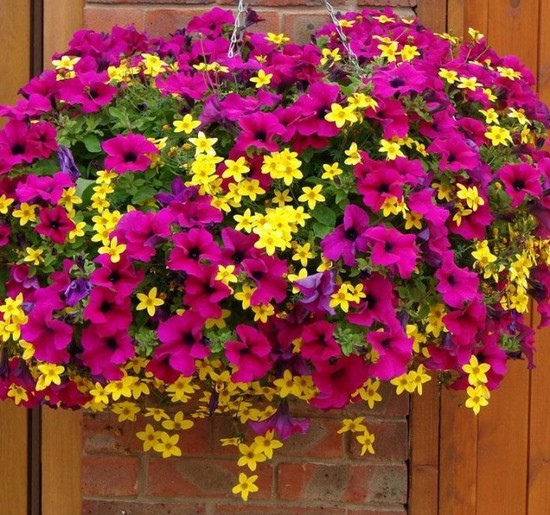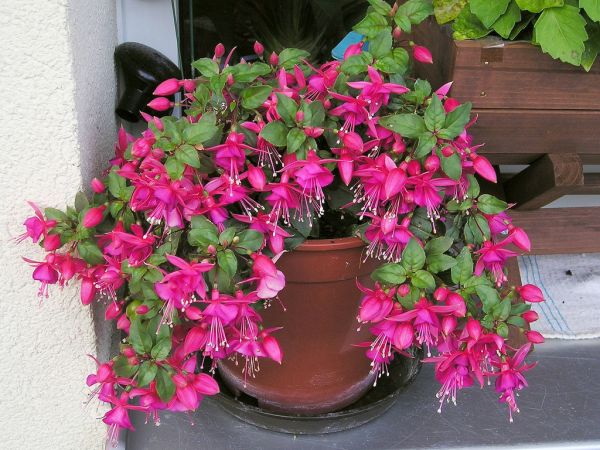Every gardener knows that plants grown in hanging containers are called ampelous. The fact is that the word ampel is translated from German as "hanging vase." This method of gardening is the best suited for decorating balconies of verandas and gardens: a basket with flowers not only looks very festive, but is also noticeable from any angle. In addition, it saves space. Today we offer to talk about garden and indoor ampel plants. The names and photos of green pets are waiting for you below!
Petunia
Perhaps the most popular plant can be called petunia. This summer plant came to Europe from America, more precisely, from Brazil. Initially, Jean-Baptiste Lamarck described this genus called tobacco. 10 years later, the petunia was separated into a separate genus. The name of the ampel plant comes from the word petun - that's what tobacco is called in Brazil.
The first variety of petunias appeared in 1839. After 16 years, terry varieties were bred, and after another 26 years, large-flowered representatives of the genus appeared. The ampelous petunias, bred in the sixties of the last century, deserve special attention.
Description of the plant and rules for its care
This ampelous plant differs in the shape of the corolla: there are petunias with a fringed edge of the petal, a wide pharynx. There are many different shades: flowers can be red, purple, white, blue and pink. Nowadays, gardeners say, there isn’t only orange and deep yellow petunias. Due to the drought resistance of petunias, they are often planted in containers. Ampel ones are ideal for hanging baskets. Please note: this bright flower perfectly tolerates a dense planting, and therefore, three plants can be planted in the flowerpots, whose diameter is 15 centimeters. Such a composition will delight you with its magnificent flowering. However, you can plant seedlings less frequently, so that the plants do not touch each other. Florists are advised to plant ampelous petunias with a slight slope to the edge of the cache-pot.

Ideal soil - neutral in its acidity, quite nutritious, loose and light. As for care, petunias will need regular watering and fertilizing. If the planting is too tight, this ampel plant needs thinning, it is also important to remove weak and diseased shoots. In addition, after planting, you need to pinch the petunia several times.
Surfinia
A hybrid of ampelous petunia called Surfinia is gaining increasing popularity among gardeners. At first glance, it might seem that the difference between petunia and surfinia is minimal. However, it is worth noting that the latter is slightly higher than its relative, in addition, its stems are much stronger. This variety was bred by Japanese breeders. Florists and landscape designers say: this flower allows you not to limit yourself in creativity.
Surfinia blooms very magnificent, you can verify this by looking at the photo of the ampel plant. If we talk about shades, there are surfinies of white, pink, purple, burgundy, yellow and other tones. Incredibly bright flowers gather in lush bunches, thanks to a huge number of long stems, a fluffy hat is formed quite quickly. The lower stems lean towards the ground, forming a magnificent flowery waterfall.
Types of Surfinia
To date, there are about 20 species of this hybrid ampelous petunia. The following grades are especially popular:
- Burgundy This variety is characterized by a wine shade of flowers. The bush is large enough and thick.
- Hot Pink. This species is distinguished by bright pink flowers with raspberry veins.
- Table White. The flowers of this surfinia outwardly resemble small bells.
- Elow. As the name implies, this ampel plant has a pleasant yellow color.
Care Features
Like petunia, surfinia needs a lot of sunlight, and therefore should be placed in a well-lit place.
If you decide to grow this amazing flower in your garden, provide it with a canopy that protects it from rain. It is worth noting that surfinia is much more tender than petunias, and therefore it is necessary to feed and water it a little more often. In late summer, the plant needs pruning. Florists recommend moving plants for the winter in a warm room. If you save it from frost, in the summer it will be able to decorate your garden again.
Verbena
Speaking about the names of ampelous plants, a photo and a description of them, one cannot but mention the beautiful verbena. This grassy flower is ideal for planting in hanging baskets, because its stems hang down 60 centimeters. This is the main difference between ampel verbena and upright verbena. It is worth noting that this plant grows incredibly quickly, in a short time it is able to cover an area of about 0.5 m 2. Ampel verbena was bred as an ornamental plant, suitable for both the garden and the windowsill. From other species, it differs in fairly small flowers and openwork foliage. As for coloring, it can be very different: there are flowers of purple, red, blue and pink.

Perhaps the most popular ampel verbena is the Imagination variety. This plant is characterized by a pleasant lavender tone of the petals and neat foliage. In order for the plant to please with abundant flowering and bright color, it must be regularly fed. For this purpose, any complex fertilizer is suitable. At a time when verbena is increasing its leaf mass, gardeners recommend increasing watering and introducing nitrogen. When buds are planted, this ampel plant will require phosphorus, manganese, and potassium. It is worth noting that this type of verbena is extremely unpretentious, it can easily endure cooling to -3 degrees, drought. The only thing that is contraindicated for verbena is waterlogged soils with a large amount of mineral salts.
Amp fuchsia
Why is fuchsia so appreciated by gardeners? Most likely, the reason is a very long and plentiful flowering. Outwardly, it looks like a bush or tree, the flexible branches of which have a reddish tint.
Fuchsia flowers can be very different, and not only monochromatic, but also bicolor ones are found. From the stems hang lanterns of blue and pink, purple and orange, red and white. It is worth noting that fuchsia is extremely undemanding and unpretentious, its flowering begins in April and continues until October.
Growing as a houseplant
It will be useful to know that the cultivation of ampelous fuchsias as garden and indoor plants has a number of differences. Let's start with the features of caring for an indoor ampel plant (in the photo below you can see it at home). These plants do not like direct sunlight, so flower growers recommend keeping them on the east, north or west window. From a too bright sun, fuchsia should be a little shaded. A special role is played by the preparation of the plant for winter. The fact is that it enters a period of rest, and therefore it should be kept in cool and dark. The optimum temperature is no higher than 4-8 degrees.

Watering should be limited. At the beginning of spring, ampule fuchsia must be cut off, a larger pot should be selected for it, transplanted and placed on the windowsill. If you did everything right, fuchsia will give new shoots and begin to bloom. Please note: it is not recommended to rearrange or turn over the container with flowers during flowering, otherwise the flowers will begin to fall off. During flowering, an ampoule indoor plant must be abundantly watered and sprayed regularly. Carefully ensure that the soil in the flower pot is not waterlogged. Once every 10 days, it is necessary to feed fuchsia with mineral or organic fertilizers. Observe the dosage: the application of excess nutrients will cause the green pet to grow leaves and reduce flowering. Regularly break off withered flowers - this will allow you to gain new strength.
Florists share the secrets of growing indoor fuchsias:
- Particularly hot summers, these plants should be removed in the depths of the room. It is necessary to put ice next to the pot - this procedure will save the plants from the loss of buds and leaves.
- It is best to grow this flower in ceramic pots. The thing is that in hot weather in such a capacity the roots of the plant practically do not heat up.
Garden cultivation
As an ampule plant for the garden, this type of fuchsia is just perfect. Gardeners say: you can grow fuchsia both in hanging baskets and in flower beds. It is important to know that the tropical beauty is very thermophilic, and therefore in the northern latitudes it can be grown only as annuals. This flower prefers the moderate sun, from scorching rays it must be hidden. In addition, he needs moderate hydration. Gardeners say: the most suitable container for garden ampel fuchsias is an ordinary wire basket filled with peat moss. You can add perlite and vermiculite: they will retain water, which means that plants can be watered less often.

At the end of August, when the days are getting shorter and the nights are cooler, you should think about the future fate of the fuchsias. Some gardeners simply carry the flower into the room. At home, caring for garden fuchsia is no different from caring for a houseplant. In early spring, plants should again be placed in a warm atmosphere, begin to fertilize. Fuchsia should be taken out to the street when tomatoes are planted.